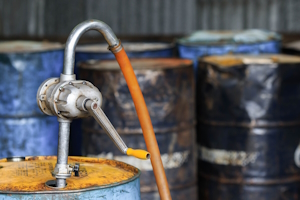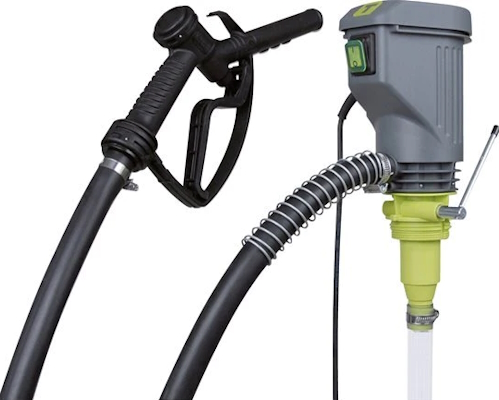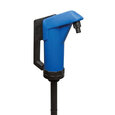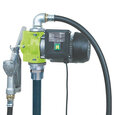Drum Pump - How It Works

Figure 1: A manual drum pump used to pump oil from a barrel.
Drum pumps are tools used to move liquids from big containers, like oil barrels, to other containers. There are three main kinds of drum pumps: manual, electric, and pneumatic. Each kind uses a different way to move the liquid. This article explains how each pump works and what it is best used for. By learning about these different pumps, people can choose the best one for their needs.
Table of contents
View our online selection of drum pumps!
Drum pump actuators
Manual, electric, and pneumatic drum pumps have very similar designs and operating principles. The primary difference is how the pumps are powered.
- Manual: Manual drum pumps, or drum hand pumps, have a rotary handle (rotary drum pump) or lever that a user operates to create suction.
- Electric: Electric drum pumps use an AC or DC motor to power the pump's impeller. These motors have varying power depending on requirements.
- Pneumatic: Pneumatic drum pumps use an air motor or air-operated diaphragm pump mechanism that is driven by the flow of compressed air or gas.

Figure 2: An electric drum pump
Design
Beyond the actuator design, these pumps have similar components:
- Suction pipe: The suction pipe is the long tube that reaches down to the bottom of the drum. This pipe is typically made of plastic, stainless steel, or another corrosion-resistant material, ensuring it can handle a wide range of fluids. The material used to construct the suction pipe must be resistant to the material being pumped. Read our chemical resistance guide to learn more.
- Discharge spout: The discharge spout is where the fluid exits the pump. The fluid is directed from here into a container or another storage unit.
Operating principle
Operating a drum pump is straightforward.
- Priming the pump: The suction pipe is inserted into the container containing the liquid to be transferred.
- Operating the pump: The user operates the actuator to create a vacuum inside the suction pipe, which causes the liquid to be drawn upwards from the drum. A centrifugal pump has a rotating impeller which creates suction for a drum pump. The rotating impeller increases the fluid's velocity and lowers its pressure. This causes the fluid to move from an area of higher pressure (the drum) to an area of lower pressure (the pump), thus creating suction. The centrifugal force from the rotation helps to maintain this flow and pressure difference.
- Discharging the fluid: The liquid is pulled upwards through the suction pipe and out through the discharge spout.
Applications
Although they operate similarly, the three types of drum pumps are suitable for different types of applications.
- Manual: The primary benefit of a hand-operated drum pump is that it does not require a power source. This drum pump type is suitable for jobs that require a small amount of liquid to be transferred. The liquid should be low-viscosity (e.g., water, light oils, and mild chemicals). An example type of pump is a water drum pump.
- Electric: An electric drum pump can transfer large volumes of liquids, including high-viscosity liquids (e.g., electric oil drum pump). This high-viscosity drum pump provides a continuous flow, making it suitable as a chemical drum pump or a food-grade drum pump.
- Pneumatic: A pneumatic drum pump does not require electricity to operate. Therefore, this type of drum pump is safe in environments where there's a risk of explosion or fire (e.g., petroleum, chemical, and paint and coatings industries). This type of pump can be a drum pump for gasoline.
Selection criteria
Consider the following criteria when choosing between drum pumps:
- Pump speed: The flow rate of a manual drum pump depends on the user's effort. Typically, however, manual drum pumps have lower flow rates than electric and pneumatic pumps. Electric drum pumps tend to have the highest flow rates, whereas pneumatic pumps offer variable speeds controlled by air pressure.
- Material: Each type of drum pump is typically made from plastics, cast iron, or stainless steel, depending on the compatibility with the pumped fluids.
- Power availability: Manual drum pumps are the only pumps that don't need an external power source. Electric drum pumps need a steady electricity source and pneumatic drum pumps need compressed air and a pneumatic system.
- Self-priming: Self-priming for a drum pump refers to the pump's ability to vent air from the suction line and prime itself without needing manual intervention. Typically, any type of drum pump is self-priming. Check with the manufacturer to be sure.
FAQs
What is a drum pump?
A drum pump is specially designed to fit inside a large container and transfer fluid from it to a different container.
How does a pneumatic drum pump work?
A pneumatic drum pump uses compressed air or gas to power the pump and create the suction necessary to pull liquid from a barrel.







